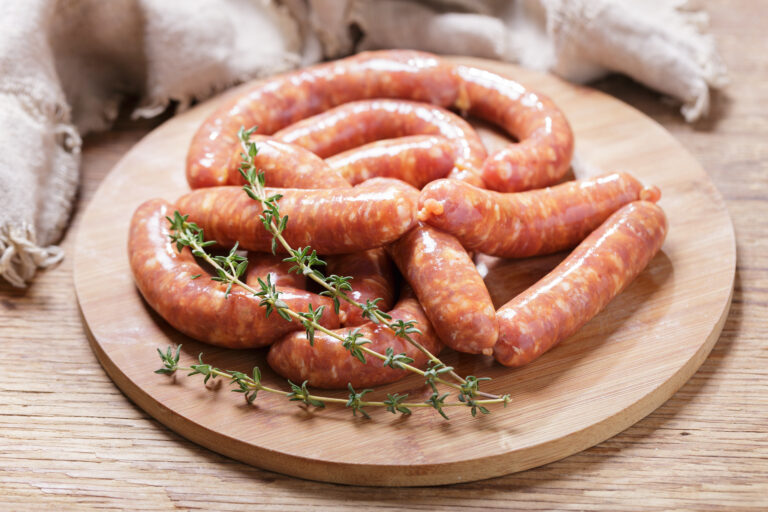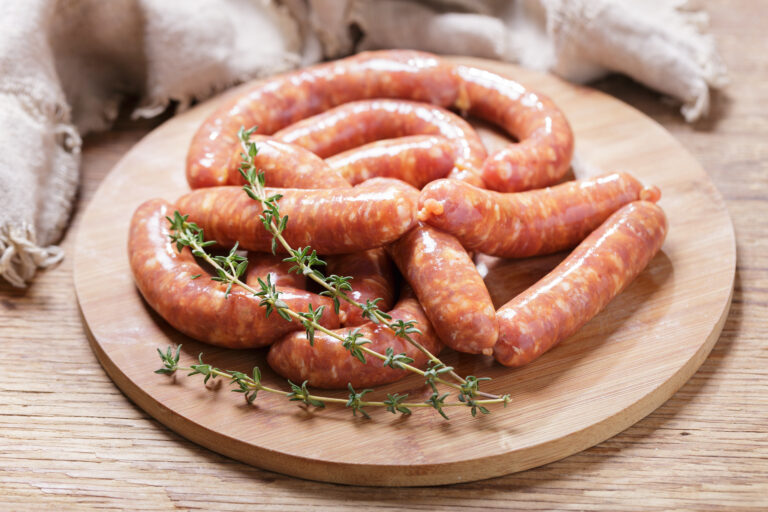5 Ways Polish Kielbasa Enhances Your Culinary Experience
Kielbasa, a versatile Polish sausage, comes in various types and is prepared with different meats and spices before being cooked through methods like grilling, roasting, or steaming, showcasing Poland’s rich culinary heritage and dedication to sausage-making.

Sausage is a rustic comfort food that stands as a tribute to our ancestor’s dedication to preserving their natural resources and ability to coax complex flavors out of simple ingredients.
Perhaps no sausage better showcases those abilities better than the Polish kielbasa.
Humble in origin yet bold in flavor, kielbasa sausage is a Polish national treasure (note that it’s different than Polish Ham). Since the 14th century, the Poles have been known for their impressive variety of sausages, each with its own unique blend of meats, spices, and preparation methods.
Contrary to popular belief, the word kielbasa isn’t a single kind of Polish sausage but actually encompasses any ground meat encased in a skin that you can find across the country of Poland.
In fact, the word “kielbasa” comes from the Old Slavonic word “klasba,” which means “something puffy and convex,” which perfectly sums up the essence of what a sausage is.
Fresh kielbasa is available throughout eastern Europe, especially in the nations closest to Poland (even Germany and Hungary).
For example, Russian kielbasa is hard, salted, air-dried, and then stored for winter food. This sausage-making practice started to help poor, rural farmers make it through bone-chilling winters when crop failures and food shortages were common.
Ukrainian “kovbasa” is often made in the family kitchen, roasted in a hot oven, then stored in a ceramic dish full of lard. When someone has a hankering for sausage, the kovbasa is sliced and served on hearty rye bread with a prepared mustard sauce.
Today, though, we’ll be focusing on Poland’s impressive repertoire of sausage-stuffing skills, including preparations, regional specialties, and a few recipes that showcase the nuanced flavor of this treasured meat.
Disclosure: As an Amazon Associate, this site earns from qualifying purchases. Thank you!
How Kielbasa is Prepared
Whether you prefer your kielbasa smoky, savory, and plump or heavily spiced, cured, and matured, there are nearly infinite ways to prepare Poland’s go-to source of protein.
Despite the differences, most kielbasa begins its delicious life in much the same way.
First, a meat or meat blend forms the basic recipe. Popular picks include pork, chicken, beef, and veal, but it’s not uncommon to find turkey and venison kielbasa sitting on a deli display case.
Poland takes its sausage very seriously, with regulations in place to ensure the highest quality. A kielbasa isn’t labeled as a particular type of meat — like pork or beef — unless the sausage comprises at least 75% of that specific protein.
Once you’ve chosen your meats, it’s time to move on to spices.
Some recipes call for a simple blend of salt, pepper, and garlic. Others have more complex spice blends that often include marjoram, juniper, paprika, rosemary, and caraway.
The meats and spices are ground together into a uniform blend, then stuffed (with a sausage stuffer or attachment) into either an artificial casing or authentic animal intestines. Once it’s perfectly “puffy and complex,” kielbasa aficionados choose a cooking technique:
Raw
Raw kielbasa is distinguished from other types because they are either lightly smoked or left entirely unheated.
In some varieties, the aged sausage is enhanced with yeast to create interesting new flavors throughout the drying process.
Baked
Baked kielbasa is a cuisine technique mostly practiced in southern Poland, but the name is a little misleading.
Lisiecka and other sausages prepared in this way are not baked in an oven but smoked at much higher temperatures than normal.
Steamed
Steamed kielbasa undergo parboiling before smoking and drying. From there, boiled sausages split off into semi-dry and dry categories.
Semi-dry sausages are fully cooked and partially dried, which gives it a softer texture infused with a smoky flavor.
Dry sausages contain plenty of curing ingredients, like salt, which help them keep from spoiling during their longer maturation process. While they are drying, most links lose around 40% of their weight, which creates a more full and distinct flavor profile.
Because they keep well outside of refrigeration, dry sausages are often the preferred provision for campers, hikers, and other outdoorsmen.
Types of Kielbasa
Across the sixteen provinces of Poland, there are nearly limitless regional varieties of kielbasa.
Because of its humble beginnings in rural homes, generations of families have come up with their methods of spicing, preparing, and serving this staple of Polish cuisine:
Kielbasa Weselna
Also known as “wedding sausage,” this variety of kielbasa is a must-have at nuptials and get-togethers because of its folkloric ability to sober up guests.
It’s well-balanced meat, bringing together savory pork, fresh garlic, and black pepper with a hint of sugar to offset the spice.
Krupniok Śląskie
With its intriguing purplish-black color, krupniok śląskie is an eye-catching kielbasa with a complex flavor.
Along with the traditional ingredients of pork, salt, pepper, garlic, and marjoram, you’ll find pig’s blood, buckwheat, allspice, and onions.
Polish blood sausages were once reserved for special occasions, but Poles enjoy them as an everyday delicacy with mustard, pickled veggies, and a beer.
Parówki
This tiny sausage packs a big flavor with a delicate blend of finely ground veal and pork.
Parówki is often served boiled and steaming hot alongside a hearty breakfast, which is where it got its name– Para is the Polish word for “steam.”
Biala Kielbasa
The versatile and straightforward biala kielbasa is made from tender pork ground with a touch of beef to achieve the perfect consistency.
The natural casing on the outside contains moist meat spiced with salt, garlic, pepper, and marjoram.
It’s also known as Polish white sausage because of its consistently light coloring before and after cooking.
Because it’s a raw sausage, biala kielbasa requires a quick dip in boiling water before baking, sauteing, or serving in a soup.
Kielbasa Żywiecka
Hailing from the Żywiecka region of Poland, Kielbasa Żywiecka is also called dry beer sausage. Its firm texture and even marbling come from fatty diced pork seasoned with garlic, salt, and pepper.
The links are hardwood smoked for a more complex flavor. Despite its name, beer is not on the ingredient list. It’s often used as a cold cut on sandwiches or served hot on pizza.
Żymlok
Żymlok is another variety of blood sausage, originating in Silesian Voivodeship.
It has one of the most exciting recipes, including bread rolls soaked in meat broth, pork blood, offal, and aromatic spices like nutmeg, bay, allspice, juniper, and marjoram.
Its name reflects its components, as żymla and bulka mean “bread rolls” in Silesian and Polish.
Kielbasa Czosnkowa
Garlicky kielbasa czosnkowa is classically prepared with smoked pork, pepper, and marjoram, along with a hearty helping of fresh garlic.
It’s the most similar to the kielbasa we commonly see on supermarket shelves in the United States, but with a deeper, more robust flavor.
How to Cook Kielbasa Well
Ready to put your tongs to the test?
Your kielbasa cooking method will change depending on which type you are working with.
Some Polish sausages are excellent served as a cold cut on a deli sandwich or as a protein on your charcuterie board.
Others, like biala kielbasa, must be heated to a specific temperature of 160 degrees before they are safe to eat.
There are a few good rules of thumb for techniques based on what type of kielbasa you’re going to sink your teeth into:
Grilling
Grilled kielbasa is delicious, juicy, and the perfect way to enjoy Polish flavors without warming up your home with the stovetop.
Biala kielbasa is a fantastic accompaniment to your summer barbecue menu. Serve it with thick-cut bread or a side of horseradish or with peppers and sides.
Jalowcowa gets its flavor from juniper berries mixed into the medium-ground pork. It’s dry-smoked in juniper wood, further infusing this full-bodied sausage with flavor. Because jalowcowa is fully cooked, it will warm up fast on a hot grill. Try it with sauerkraut!
Podwawelska is a medium-ground sausage seasoned with garlic before being steamed and smoked. Enhance its mild flavor with a brief stint on your grill grates.
Once your grill is nice and hot, it’s time to get cooking:
Cut slits in your sausage casing to prevent splitting.
Lay your kielbasa on the grill for 4-5 minutes.
Flip, then grill the other side for an additional 4-5 minutes.
Remove and rest before slicing to prevent the juices from running.
Snacks and Charcuteries
The easiest way to enjoy kielbasa is to slice and eat! That’s why these fully-cooked varieties make prime choices for your charcuterie board:
Lisieka is a “baked” sausage, which means it’s smoked at a higher temperature than usual. Bring out the garlicky goodness with delicate cheeses and mustards.
Salceson, or head cheese, isn’t exclusive to Poland, but the Polish people have genuinely refined the art. It’s a combination of ears, tongue, and offal mixed with regional ingredients like mushrooms, blood, salmon, or chives to create more distinct flavors.
Kabanos is a dish best served cold. The drier it is, the more intense the taste. Cooking dulls much of the smoky flavor and spicy kick that makes it so delicious. Kabanos make for popular party fare, where you can find the sausage wrapped in cheese and bell pepper.
For the authentic Polish culinary experience, load up your board with pickled veggies, thick-cut bread, preserves, horseradish, and a smoked cheese like Radamer, Golka, or Oscypek.
Soups
From Sour Rye Bread Soup to soul-warming kartoflanka potato soup, kielbasa makes these classic Polish dishes rib-sticking and satisfying.
Kielbasa czosnkowa is a fantastic addition to sausage stews because of the extra garlic flavor packed into every succulent bite. Marjoram and coriander round out the flavor profile.
Biala kielbasa gets a second appearance here because of its celebrity status as the main ingredient in Polish White Borscht, a traditional Easter soup loaded with potatoes, eggs, and spices.
The cooking method for a soup kielbasa will vary based on which dish you’re preparing, but in most cases, you have the option of serving the sausage sliced or whole.
If serving whole, you can poke a few holes in the links to help them cook more evenly.
Roasted or Pan Fried
When you want to give your grill a break, you can create savory kielbasa treats right on your stovetop or in your oven.
Bydgoska is a thin, raw kielbasa most often served warm to bring out the mustard, juniper, and bay leaf it’s spiced with. The links are often pan-roasted, then paired with potato dumplings or braised red cabbage.
Slaska is a pretty basic, mild pork sausage, but that simplicity makes it all the more versatile. If you’re new to kielbasa, a plump slaska link is an excellent place to start.
Delicious, hearty, and rustic, wiejsja has a much thicker casing to hold in the chunks of seasoned pork. This “farmhouse sausage” is a blend of pork, veal, garlic, and marjoram.
Remember not to boil cooked kielbasa before roasting or pan-frying. It’s unnecessary, leeches out the flavor, and can give your links an unpleasant texture.
To pan-fry:
Warm a teaspoonful of oil in a frying pan
Cut your kielbasa into slices or lengthwise halves
Add your sausage to the oil and cook until crisp and browned on the outside
To roast:
Set your oven to 350-degrees
While waiting for the oven to preheat, grease a baking pan
Place your kielbasa in the pan, then roast uncovered for 15-20 minutes.
Let it rest before slicing to help it maintain its juiciness.
Where to Buy Kielbasa
You don’t have to hop on a plane to satisfy your craving for authentic kielbasa. Online meat markets give sausage fans the chance to stock up on old favorites or try something new without ever leaving the comfort of their home.
Polish Deli Online offers a vast selection of kielbasas, including classic Polska, juniper-smoked jalowcowa, and even sampler packs that let you try a little bit of everything! Their prices are affordable, with prices ranging between 10.99-20.99 a pound. One of their newest products is a 4-pack of kielbasa burger patties, perfect for grilling and sharing with friends.
Sweet Poland is similar to the above site but with even more options for people who want a full tour of Poland’s kielbasa selection. Their kabanosy swojskie, or Smoked Links Old Country Style, won about.com’s 2012 award for best Eastern European Sausage. Another tasty must-try is the kielbasa domowa, a traditional sausage with an intensely smoked, garlicky flavor.
If you want to shop locally, visit your area butcher. Kielbasa sausages are often available through deli counters, though you may not find as wide a variety as you can online.






